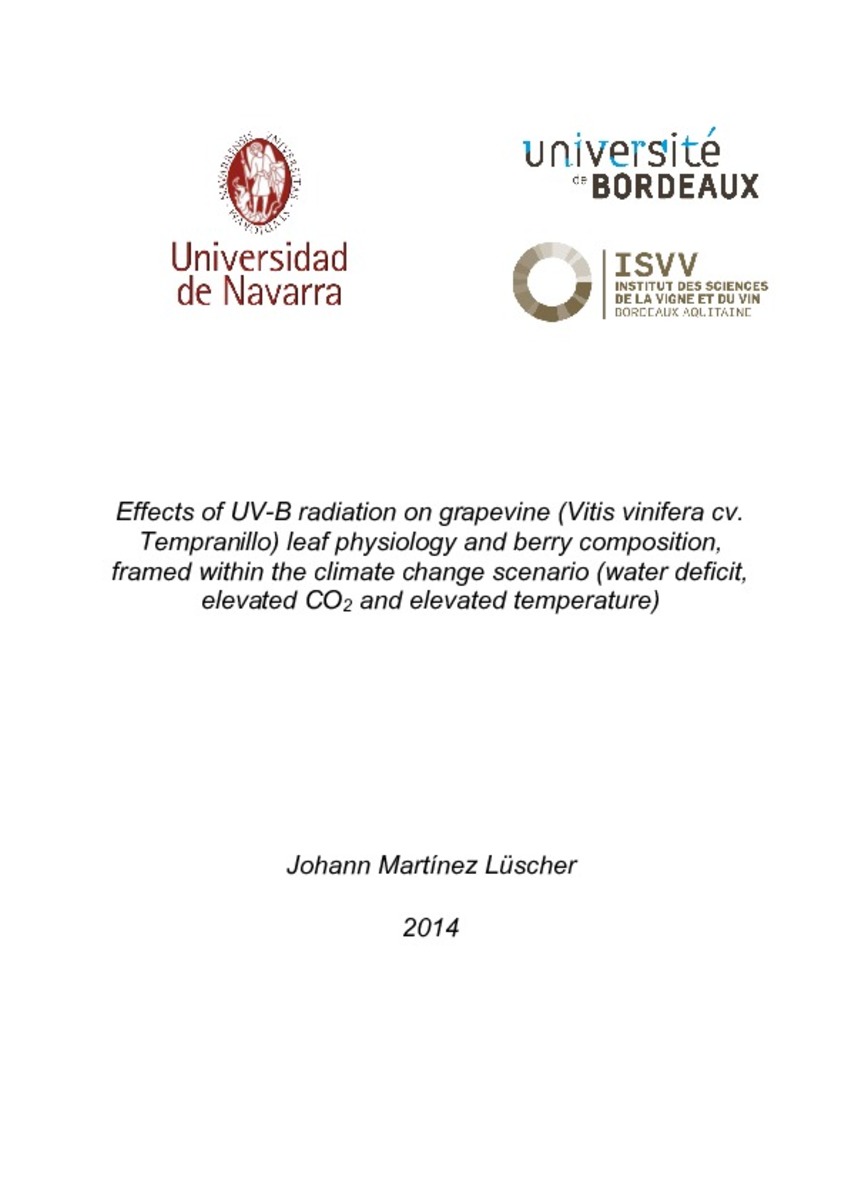Full metadata record
| DC Field | Value | Language |
|---|---|---|
| dc.contributor.advisor | Aguirreolea, J. (Jone) | - |
| dc.contributor.advisor | Pascual-Elizalde, I. (Inmaculada) | - |
| dc.creator | Martinez-Lüscher, J.D. (Johann David) | - |
| dc.date.accessioned | 2015-12-01T12:19:00Z | - |
| dc.date.available | 2015-12-01T12:19:00Z | - |
| dc.date.issued | 2015 | - |
| dc.date.submitted | 2014-11-28 | - |
| dc.identifier.citation | MARTÍNEZ LÜSCHER, Johann. “Effects of UV-B radiation on grapevine (Vitis vinifera cv. Tempranillo) leaf physiology and berry composition, framed within the climate change scenario (water deficit, elevated CO2 and elevated temperature)”. Pascual Elizalde, Inmaculada (dir.), Aguirreolea Morales, Jone (codir.). Tesis doctoral. Universidad de Navarra, Pamplona, 2014 | es_ES |
| dc.identifier.uri | https://hdl.handle.net/10171/39469 | - |
| dc.description.abstract | The aim of the thesis was to assess the effect of UV-B radiation on grapevine Vitis vinifera cv. Tempranillo leaf physiology and grape berry composition, framed within the climate change scenario. Grapevine fruit-bearing cuttings were exposed to three UV-B doses (0, 5.98, 9.66 kJ m-2 d-1) under greenhouse conditions. The combined effects of UV-B and water deficit, as well as, UV-B and elevated CO2-temperature (700 ppm, +4ºC), applied from fruit set to maturity were also tested. The results show that initial down-regulation of photosynthesis was followed by an acclimation, mediated by the accumulation of UV-B absorbing compounds and antioxidant response elicitation (flavonoids and antioxidant enzymes). Berry ripeness was delayed by UV-B exposure and water deficit, especially when they were applied in combination, whereas it was hastened by elevated CO2-temperature. In the last case, UV-B attenuated the effect of elevated CO2 and temperature. Changes in berry ripening rates were associated with changes in photosynthetic performance. Grape berry skin flavonol and anthocyanin concentration was increased by UV-B, mainly due to the up-regulation of the structural (CHS, F3¿H, FLS, UFGT and GST) and regulatory genes (MYBF1 and MYBA1) committed to their synthesis. Quantitative changes in flavonol concentration induced by UV-B were always associated with qualitative changes in flavonol profile (i.e. increased relative abundance of mono- and disubstituted flavonols), as a result of the competition of FLS with flavonoid hydroxylases (F3¿H and F3¿5¿H) for the same substrates. The up-regulation of FLS and F3¿5¿H by UV-B radiation and water deficit, respectively, resulted in an interactive effect on the flavonol B ring hydroxylation pattern. Under elevated CO2-temperature anthocyanin-sugar accumulation was decoupled. However, UV-B partially alleviated this uncoupling by up-regulating anthocyanin biosynthesis and modulating berry ripening rates. | es_ES |
| dc.language.iso | eng | es_ES |
| dc.rights | info:eu-repo/semantics/openAccess | es_ES |
| dc.subject | Flavonoid profile | es_ES |
| dc.subject | Photosynthetic response | es_ES |
| dc.subject | Climate change | es_ES |
| dc.subject | UV-B radiation | es_ES |
| dc.subject | Grapevine | es_ES |
| dc.subject | Fisiología vegetal | es_ES |
| dc.subject | Agronomía | es_ES |
| dc.subject | Fisiología de la maduración | es_ES |
| dc.subject | Botánica | es_ES |
| dc.subject | Biología vegetal | es_ES |
| dc.title | Effects of UV-B radiation on grapevine (Vitis vinifera cv. Tempranillo) leaf physiology and berry composition, framed within the climate change scenario (water deficit, elevated CO2 and elevated temperature) | es_ES |
| dc.type | info:eu-repo/semantics/doctoralThesis | es_ES |
Files in This Item:
Statistics and impact
Items in Dadun are protected by copyright, with all rights reserved, unless otherwise indicated.






